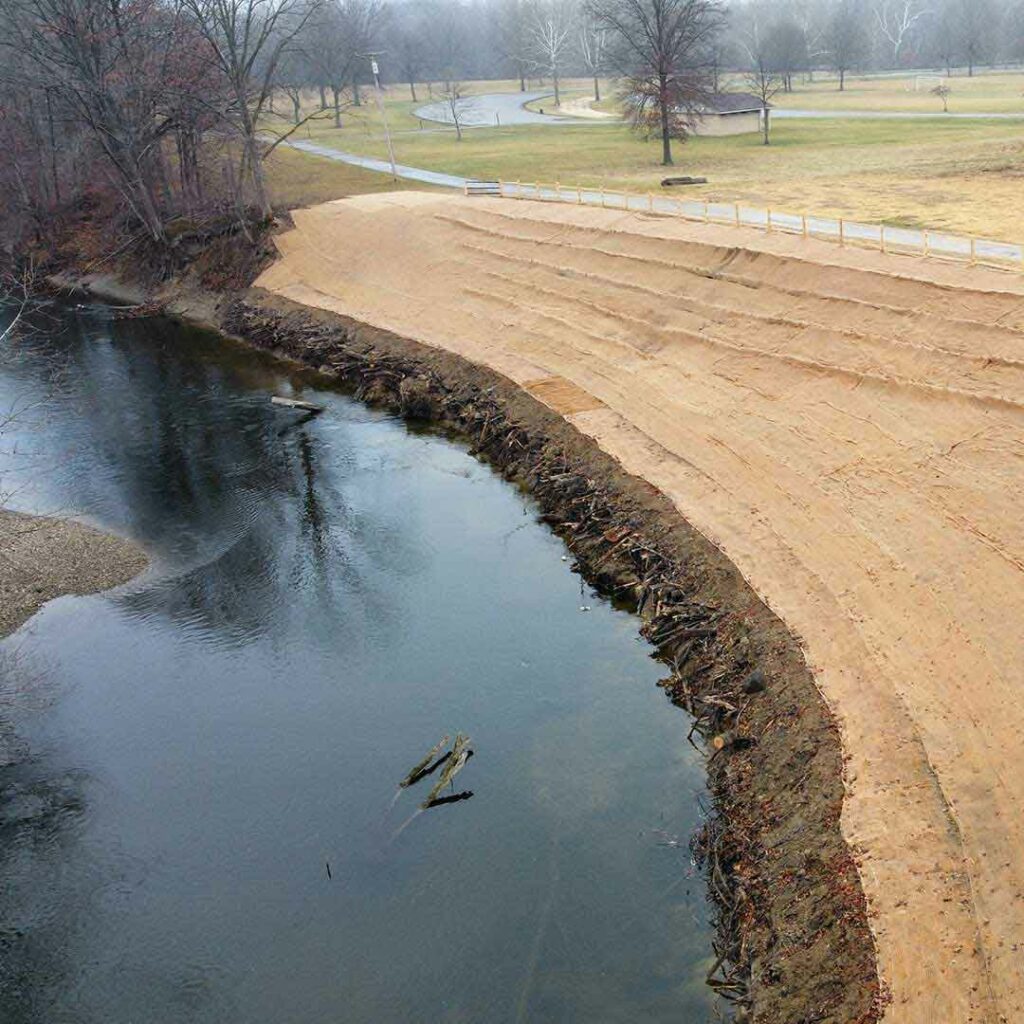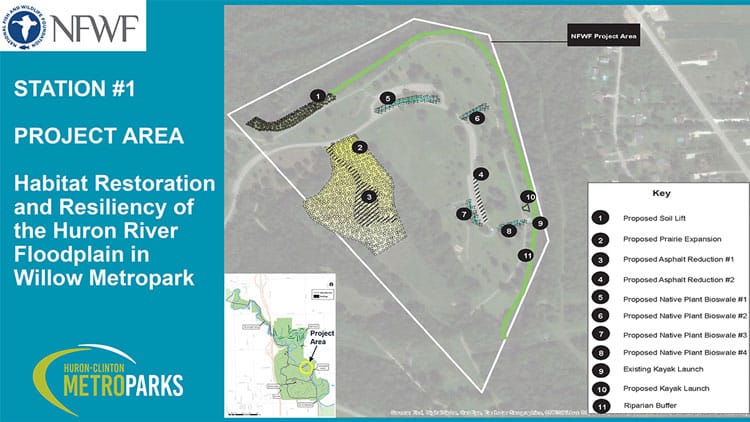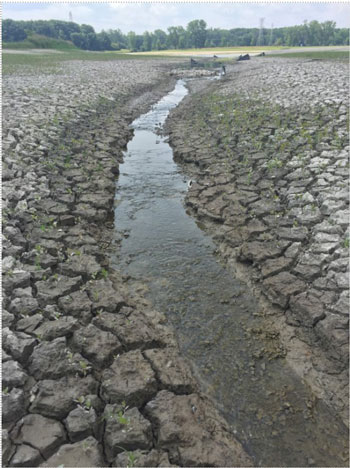Projects tackle shoreline erosion and restore a creek. One new restoration project is underway and another is planned by the Huron-Clinton Metroparks for two areas in Willow Metropark in the lower Huron River watershed. Metroparks is partnering with HRWC to make the best restoration choices and gather input from the public. Check out the Metroparks story map of the Big Bend project here: Restoration and Resiliency of the Huron River Floodplain. All combined, the restoration work at Big Bend will annually capture 1.8 million gallons of runoff, reduce 156 tons of sediment, and eliminate 13.2 pounds of phosphorus from the river.
Big Bend gets restored and Green Infrastructure added
Willow Metropark is the middle of three Metroparks (the other two being Lower Huron and Oakwoods) situated along the Huron River between Belleville Lake and Flat Rock. Totaling 1,532 acres of low-use recreation mixed with natural areas along the Huron, these parks are important for the quality of the river as they protect riparian lands and the river banks. As a result, the lower Huron River has better water quality compared to other urban streams in the area according to monitoring data col

lected by HRWC volunteers.
The Metroparks and HRWC identified two areas in the park that were causing erosion and nutrification problems—Big Bend and Washago Pond. Big Bend is a picnic and recreational area with a canoe/kayak launch at the Huron River where, as the name suggests, the river carves a substantial bend. At the start of this bend, the force of the river has eroded away a hillside (releasing sediments along the way) threatening park roads and trails. HRWC monitoring suggests that the bend delivered 12% more phosphorus to the river than is found further downstream. Phosphorus is an important nutrient for algal and plant growth and can cause harm to waterways through eutrophication, or excessive plant growth. Because phosphorus can bind to sediments, excess erosion is often a cause of eutrophication.
With support from HRWC, Metroparks secured a grant from the National Fish and Wildlife Foundation to stabilize the shoreline and reduce further erosion using a variety of natural restoration techniques. First, to address the severely eroded bank at Big Bend and redirect the river’s energy, Metroparks installed toe wood (from surrounding fallen trees) into the bank. Toe wood describes a technique of inserting tree trunks into a streambank along the actively eroding base (or “toe”) of a bank bend. It gets backfilled with soil on top of the logs. The new bank is planted with live willows and native plants to create a natural shoreline. The toe wood deflects energy from the river’s edge and directs it toward the center of the river preventing additional erosion and providing cover habitat for fish and other aquatic wildlife.
 In the upland section of the park area, Metroparks removed an unused parking area and created a native prairie. To help catch stormwater runoff, they sculpted four bioswales. Like rain gardens, these drainage areas are depressions planted with native, water-loving plants that keep the runoff moving slowly where it can be absorbed and infiltrated by the landscape over time. Additionally, Metroparks is expanding the riparian buffer area from the bend to the launch. All combined, the restoration work will annually capture 1.8 million gallons of runoff, reduce 156 tons of sediment, and eliminate 13.2 pounds of phosphorus from the river.
In the upland section of the park area, Metroparks removed an unused parking area and created a native prairie. To help catch stormwater runoff, they sculpted four bioswales. Like rain gardens, these drainage areas are depressions planted with native, water-loving plants that keep the runoff moving slowly where it can be absorbed and infiltrated by the landscape over time. Additionally, Metroparks is expanding the riparian buffer area from the bend to the launch. All combined, the restoration work will annually capture 1.8 million gallons of runoff, reduce 156 tons of sediment, and eliminate 13.2 pounds of phosphorus from the river.
Washago Creek to be restored

Washago Pond was once a popular feature in the middle of Willow Metropark. Made by damming a Huron River tributary called the Regan Drain, the pond was constructed to provide areas to fish and paddleboat; activities that declined over time. In 2021, runoff from a large storm overwhelmed the outlet structure and caused a breach in the dam. The pond slowly drained, leaving a dry bed behind with the stream running through it. Because dams generally alter a stream’s chemical, physical and biological processes, we supported Metroparks in their review of the environmental impacts of the dam to surrounding habitat and the river. Following consultation with HRWC and other stakeholder groups, Metroparks has decided to restore the stream habitat throughout the former pond instead of rebuilding the dam. Restoring the stream will reconnect fish habitat from the Huron River upstream to potential spawning locations and restore important floodplain habitat. The working concept for the project was approved by the Metroparks Board of Commissioners in September of 2021, but final plans are still being developed through the permitting process. Metroparks staff are controlling invasive species in the interim. To provide anglers with alternative places to fish, Metroparks is pursuing a Department of Natural Resources Trust Fund grant to install an accessible fishing platform where the Regan Drain meets the Huron River and Big Bend.
Opportunities for Public Input
Prior to completion of plans for the Big Bend project, Metroparks held four stakeholder group meetings and conducted a public survey to gather input on design concepts and gage future use of the Big Bend area. This resulted in the restoration work you can see today. A community open house at Big Bend will be held in the summer of 2023 for public engagement and input on the improvements to the area. There is still an opportunity for stakeholders to assist with the restoration design to naturalize the stream through the bed of the former Washago Pond. HRWC and Metroparks will post public feedback opportunities in the near future.
We are happy to see this great new work by Metroparks to restore these critical areas along the Huron River. Not only will they improve the quality of Huron River waters, but they will create important habitat for a variety of aquatic and terrestrial species that depend on the river for their survival. Keep up the great work, Huron-Clinton Metroparks!
—Ric Lawson, HRWC and Jason Bibby, Metroparks
This blog post is also published in the Huron River Report, Summer 2023.



